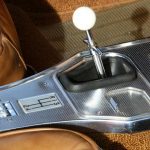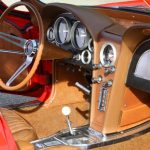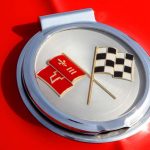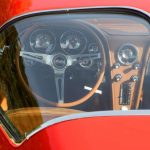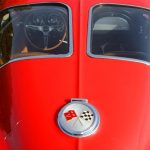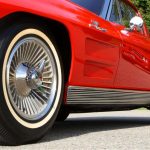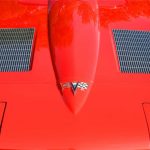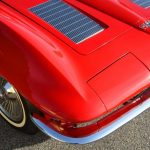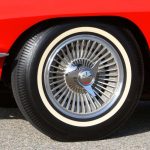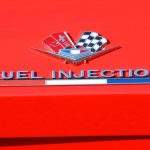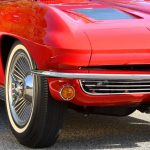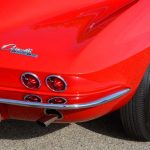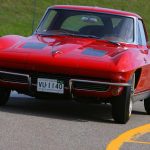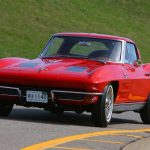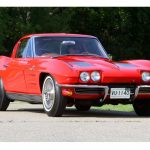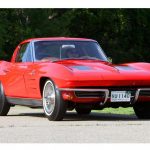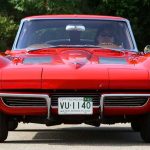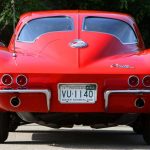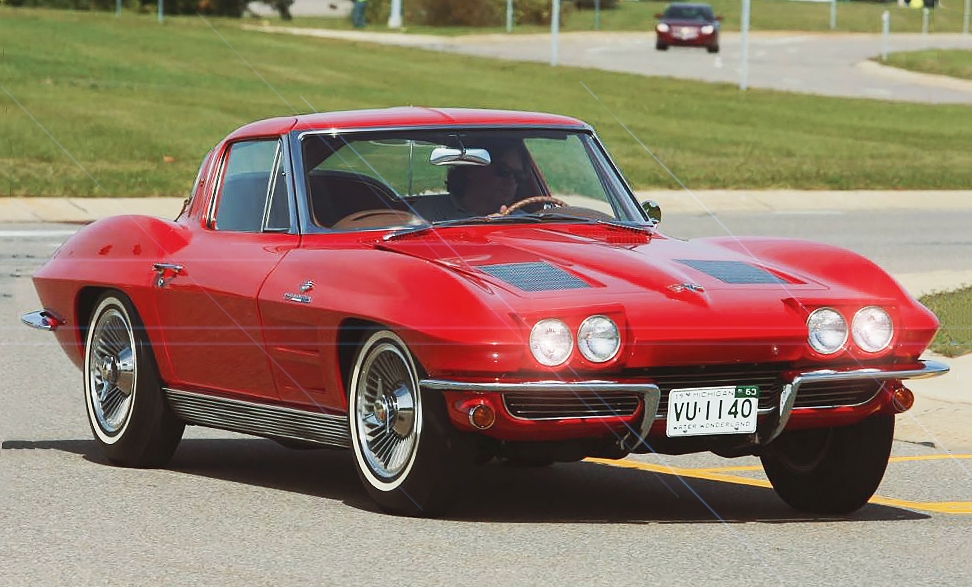
The 1963 Chevrolet Corvette Sting Ray C2 is a curious mixture of American and European concepts of what a genuine gran tourismo car should be. The road test version had the hottest of the four optional stages of engine tune available; equipped with fuel injection, this means a gross power output of 360 bhp (Small-Block FI V8). Making allowances for the power required to drive the various accessories and that absorbed by a reasonably quiet exhaust system and the transmission, it would be fair to assume that 280 bhp is available at the rear wheels — this is real power indeed.
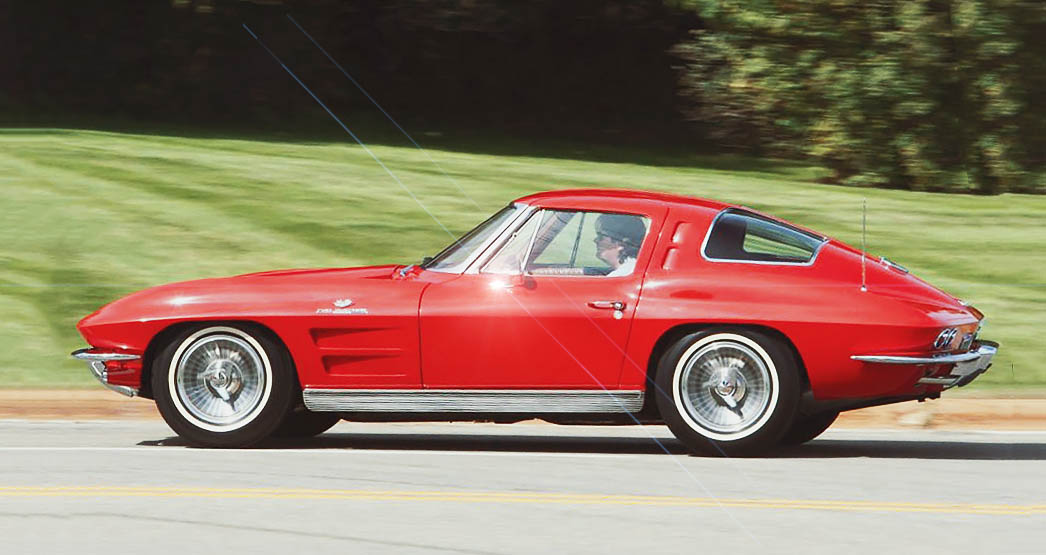
Considering that the car is only a two-seater, the kerb weight is relatively high at 29 cwt. In outline, the shape looks efficient and it must be the overall gearing that restricts the maximum speed to 146.5 mph, compared with 152.3 mph for the Aston Martin DB4 GT Zagato, and 152.7 mph for the Jaguar E-type fixed-head coupe (FHC), each with less powerful engines. The overall impression when reaching this speed was that the acceleration powers were really outstanding. On closer examination, however, it transpires that the Sting Ray will reach 120 mph from standstill in 8 secs less time than the Jaguar E-type, but takes 14 sec longer than the Aston Martin.
| GEAR | MPH | KPH |
| TOP (mean) | 146.5 | 235.7 |
| (best) | 148.0 | 238.1 |
| 3rd: | 110 | 177.0 |
| 2nd: | 86 | 138.0 |
| 1st: | 64 | 103.1 |
|
¼ mile |
14.6 seconds | |
This conflict between impression and fact arises from two causes. First gear is a very high ratio, but second and third are restively low by British standards. Moreover, the refinement, particularly in respect of engine and transmission noise, is inferior to that of most of its European competitors and this gives the impression of the car being more powerful than it really is. To the purist, some of the false styling features, such as dummy grilles and air vents in the body, appear unnecessary.
The performance is certainly vivid, but if more attention had been given to such items as tyre adhesion in the wet and wipers that clear the screen effectively above 80 mph, instead of some gimmicks which only attempt to give an impression of engineering thought, the Sting Ray would be a better car.
| 3.0 | 4.1 | 5.1 | 6.5 | 8.3 | 10.2 | 12.7 | 14.9 | 18.1 | 21.6 | 27.8 | 40.4 | TIME IN SECONDS | |
| 0 | 30 | 40 | 50 | 60 | 70 | 80 | 90 | 100 | 110 | 120 | 130 | 140 | TRUE SPEED m.p.h. |
| 30 | 40 | 50 | 60 | 70 | 80 | 90 | 100 | 110 | 120 | 129 | 139 | CAR SPEEDOMETER |
Chevrolet were the first American manufacturers to produce a genuine sports car in the post-war period, when the Corvette C1 was introduced in 1953. At that time it was a real boulevard concept. Ford at once appreciated the possibilities in this market, produced the Thunderbird, and almost killed the Corvette. Chevrolet then tried to turn it into a real racer and it did reasonably well in competition, but its success resulted from brute horsepower rather than subtle execution; in one surprising respect, however, this early Corvette proved very popular.
It was the only American car produced in large quantities which had a glass-reinforced plastic body which, incidentally, was produced with double dies and had none of the rough under-surfaces usually associated with this material. These bodies were found to stand up extremely well to the large amount of salt used on many American roads in the winter. Corrosion was non-existent and the cars maintained a very high re-sale value.
A re-designed Corvette was introduced in September, 1962, and called the Sting Ray. Our road test concerns this model and it differs from the current version, which now has a one-piece rear window and a few minor styling changes. The basis of the car, which retains plastic bodywork, is a box-section ladder-type frame, with coil springs and double wishbone front suspension. The rear wheels are also sprung independently, with a basic wishbone type of linkage and a single transverse leaf spring.
The four ranges of tune available for the 5,363cc vee-8 engine produce 250, 300, 340 and 360 bhp gross respectively. The two least powerful cars have hydraulic tappets and four-barrel carburettors. This most potent one has Rochester fuel injection and orthodox mechanical valve gear. Three- and four-speed manual transmissions are available and there is also an automatic version. The most popular choice is the four-speed all-synchromesh unit fitted to the test car. There are also two axle ratios, of which the lower was fitted to our car; it included a limited slip differential.
| Speed range and time in seconds | ||||
| mph | Top (3.70) | Third (4.85) | Second (6.06) | First (8.15) |
| 10—30 | – | – | 3.4 | 2.5 |
| 20—40 | – | 4.0 | 3.1 | 2.3 |
| 30—50 | 5.0 | 3.8 | 2.8 | 2.2 |
| 40—60 | 4.9 | 3.2 | 2.6 | 2.4 |
| 50—70 | 4.4 | 3.3 | 2.7 | – |
| 60—80 | 4.5 | 3.4 | 3.0 | – |
| 70—90 | 4.6 | 3.8 | – | – |
| 80—100 | 4.9 | 4.2 | – | – |
| 90—110 | 5.6 | 5.4 | – | – |
| 100—120 | 6.5 | – | – | – |
| 110—130 | 9.7 | – | – | |
| 120—140 | 18.8 | – | – | – |
Fuel injection is generally superior to carburettors at high engine speed, but often inferior in the lower ranges on part throttle. Providing that the accelerator pedal is not depressed when starting with the engine hot or cold, the Sting Ray fires immediately. The idling speed when hot is rather high, at 1,000 rpm, and this increased to around 1,500 rpm with the automatic rich mixture control in operation when cold.
The engine stalled occasionally in traffic and it was frequently necessary to blip the accelerator pedal to prevent plug fluffing; usually the plugs could be cleared with a short burst, using up to 4,000 rpm. On one occasion this technique failed, and it was necessary to remove a set of plugs for cleaning; to do so meant allowing the engine to cool down, for they are very close to the underside of the exhaust manifolds; a considerable amount of surrounding metalwork must be removed first, the complete operation taking about 1 ½ hours.
Apart from this the engine proved quite untemperamental, but the Sting Ray is not one of the easiest cars to drive in slow-moving traffic. The clutch has a rather peculiar action, with an initial breaking load of 48 lb, which drops to 36 lb at the end of a long, 6.5in travel. The fact that first gear is so high does not make it difficult to get the car away smoothly. However, it means that when, say, going south-west from London in peak traffic hours second is rarely required before reaching Putney or third before Hampton Court.

Space behind the seats can be used only for luggage, as the maximum head room is just over 2ft. This picture shows how the doors are cut well into the roof panel.The steering-wheel is set at a comfortable rake and the pedal angles, too, are just right. The two sun vizors have flexible frames and are thickly padded.
Many high performance engines of this type are somewhat intractable, but the power of the Sting Ray is creditably even throughout the range; it is felt to come in with real bite at about 4,000 rpm. This flexibility is apparent in the performance figures, the time interval for 20 mph speed increments in top gear being very consistent indeed from 30 to 120 mph. Above 140 mph body drag obviously becomes very high and it takes a considerable distance to build up to the maximum speed. For most road conditions there is usually an excess of torque, indicated by the fact that we were unable to record hill-climbing ability in second gear because the revolving scale of the Tapley meter came up against its stop; and on a 1-in-3 test hill, it was possible to spin the wheels over the summit. The car took off very smoothly and easily on this incline, and the pull-out handbrake just prevented it from rolling backwards.
| BRAKES | Pedal Load | Retardation | Equiv. distance |
| (from 30 m.p.h. in neutral) | 25lb | 0.48g | 63ft |
| 50lb | 0.88g | 34ft | |
| 60lb | 0.90g | 33.4ft | |
| Handbrake | 0.26g | 116ft | |
| CLUTCH | Pedal load and travel | 48 to 36lb and 6.5in |
The engine was never completely free from valve gear noise which was quite pronounced when cold. Also, above 4,800 rpm it became distinctly harsh and was also then accompanied by a disturbing transmission roughness. In fact, the car was returned for this point to be investigated, and although reduced, it was never completely eliminated. It promoted a reverberation through the body and an irritating rattle of the gear lever.
Fuel Injection Efficiency
During performance testing the gear change points were taken at 6,300 rpm and the maximum speeds in the gears at 6,500 rpm where the red segment on the tachometer commenced. The overall fuel consumption of 14.6 mpg seems very creditable in relation to engine size and the manner in which such a car is inevitably driven; it is also an indication of the efficiency of the Rochester fuel injection system, which is of the low pressure type injecting into the inlet tracts. It was even more surprising that no oil was added to, the sump throughout the 1,440-mile test.
Baulk-type synchromesh was first invented by General Motors and that of the test car operated faultlessly, even with brutal snatch changes; moreover, the gear lever movements are smooth, short and extremely light.
On a dry road the rear wheels can be spun readily in first and second gears leaving two black lines if the throttle is not eased off; in the wet, great care is needed and the throttle has to be opened with restraint, for banging it open at 80 mph in third can easily bring the tail round quite viciously. There is little cushioning in the transmission drive line and snatch movements of the clutch with sharp openings of the throttle can produce distinct clonks.
At speeds above 50 mph the ride is very comfortable. Large bumps and successive waves are traversed with a gentle rise and fall without any recurrent pitch. At low speeds, and particularly on bumpy surfaces, the ride is firm, indicating that the damper settings are rather stiff. When hitting a ridge during hard acceleration, causing one rear wheel to temporarily lose adhesion, the rear end would wiggle, and sometimes produce momentary unease.
Compared with that of many contemporary Americans, the Chevrolet’s steering is high-geared, requiring 3,4 turns from lock to lock, in conjunction with a turning circle between kerbs of 39ft; furthermore, it is light at all speeds, and extremely accurate for fast and precise cornering.
Reservations must be made about the tyres, however; plastic road lines will throw the car off course, and at speeds above 125 mph the degree can be quite disturbing, particularly if a strong side wind is blowing at the same time. In these conditions one needs to be quite brave to reach 140 mph, particularly as the tyres must then be set at their highest recommended pressures. These characteristics are not so pronounced at the lower setting.
The expert driver, taking the Sting Ray to the limit of adhesion, would discover that the car has a mild degree of understeer. With so much power available steering characteristics are of little importance in general road use as the car can be controlled very accurately by using the throttle. On fast open bends, with the power maintained, a clean accurate line can be held; on tighter turns the throttle can be modulated to control the car from the rear.
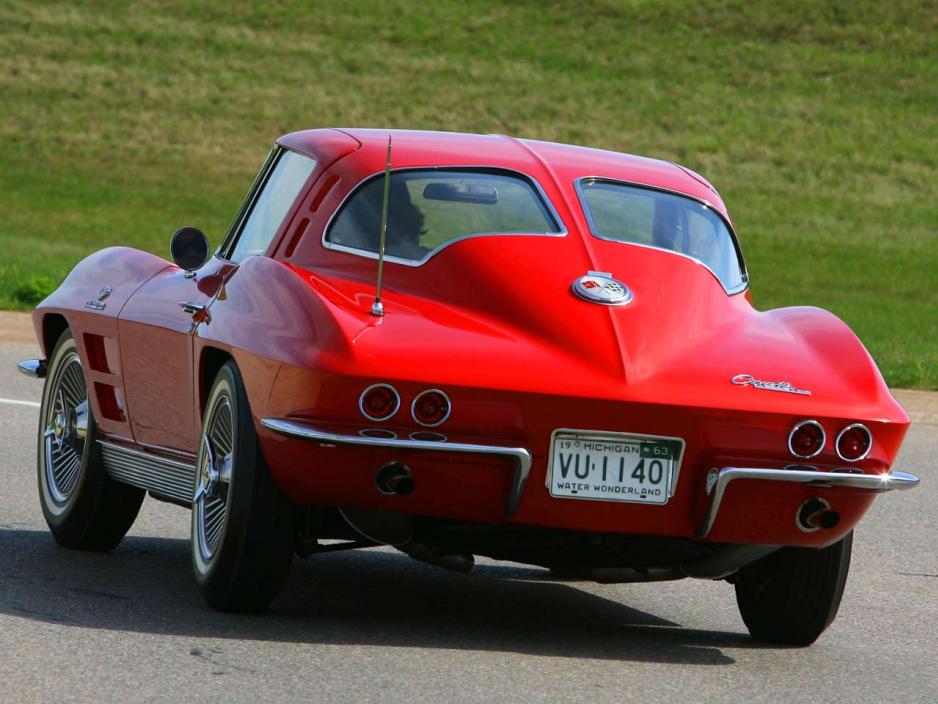
Surface and detail finish of the glass-reinforced plastic body is excellent. Centre-lock aluminium wheels are standard on this high performance version. The spare is housed in a retractable tray beneath the tail and the fuel filler in the sloping deck.
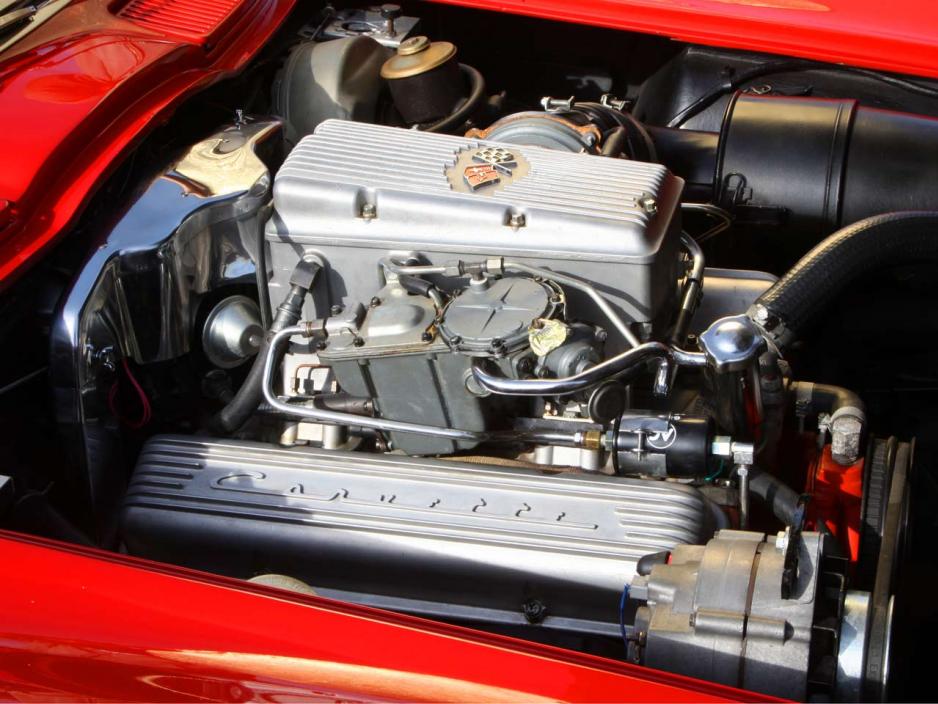
The aluminium box between the cylinder banks of the 5.3-litre vee-8 engine is part of the Rochester fuel injection system. Electrical power is produced by an alternator and the fan has a viscous coupling.
Disc brakes would be a sine qua non on a European car of this performance, but as yet they have not been widely accepted in America. To match the performance of the Sting Ray, GM have developed their own type of drum brake, which has a light alloy drum and shoes fitted with sintered iron linings; there is a self-adjusting mechanism which operates when the brakes are applied while reversing. Aided by a responsive vacuum-servo unit, they are light in operation, very powerful at all speeds and free from fade. They were not, however, completely consistent over a wide range of operating temperatures; when they were cold, the front wheels locked first with hard applications, and when very hot, the car pulled to the right and the rear wheels locked first.
| Test Conditions |
| Weather Gusty with 10-15 m.p.h. wind |
| Temperature 44 deg. F. (7 deg. C.). Barometer 29.7in. Hg. |
| Damp concrete and tarmac surfaces |
| Weight |
| Kerb weight (with oil, water and half-full fuel tank) 29.0cwt (3,248lb – 1,473 kg) |
| Front-rear distribution per cent: F, 46.5; R, 53.5 |
| Laden as tested 32.0cwt (3,584lb-1,626kg) |
| Turning Circles |
| Between kerbs L, 39ft 3in.; R 39ft 0in. |
| Between walls L, 40ft 5in.; R, 40ft 2in. |
| Turns of steering wheel lock to lock 3.4 |
|
FUEL Super Premium Grade (100-102 octane RM) |
| Test distance 1,440 miles |
| Overall consumption 14.6 mpg (19.4 lit/100 km.) |
| Normal range 16.19 mpg (16.5-17.8 lit/100 km.) |
| OIL; SAE 10W30 Consumption neglegibli |
Although the Sting Ray stands only 4ft 1in from the ground, it is very easy to enter because each body sill below the door is shallow and the top of the door is cut well into the roof line. The structure remains rigid over quite rough roads and there is little wind noise even at high speed; it was noticed, however, that daylight could be seen between the roof and the door top above 125 mph.
The seats are well designed and provide good sideways support for fast cornering; the front and fear height of the cushions can be adjusted by means of movable supports, which engage with serrations in the seat frames; and the angle of the backrests can also be modified by adjustment stops at the base. Tall drivers found that they could sit well back in relation to the pedals, but that the driving position would be improved if the steering-wheel — which has a slippery plastic rim — were set closer to the facia.
Visibility is impaired by rather thick windscreen pillars, but these are set well back. Nothing can be seen of the tail through the divided rear window, which makes reversing in confined quarters rather precarious. The one-piece window on the latest model should be an improvement.
The compartment behind the seats is fully carpeted and can be used only for stowage of luggage. It has to be loaded through the doors and over the folded seat backs, a difficult operation with bulky and heavy packages.
| GEAR | Top | Third |
| PULL (lb per ton) | 500 | 655 |
| Speed range | 86-90 | 65-69 |
There is a comprehensive set of instruments forming an are in the deeply cowled panel immediately ahead of the driver. Typically American is the very efficient heating and fresh-air ventilation system, which includes separate cold air vents. Reference has been made already to the inefficiency of the wipers at speed, but they cover a very large area of the screen. The washer jets have a strong pulsating action, but unfortunately the water is blown around the sides of the curved screen before reaching the glass at speeds above 70 mph.
How the 1963 Chevrolet Corvette Sting Ray C2 360bhp fuel injection version compares
{module Corvette C2 MPG}
{module Corvette C2 Max speed}
{module Corvette C2 -60MPH}
{module Corvette C2 14mile}
The test car was trimmed in a rather startling red plastic cloth, and there is an excess of polished metal in the interior, including the deck of the central console in which are mounted the switches for the electrically operated windows. Stowage space for oddments is limited to a lidded compartment on the passenger side of the facia, and there is a grab-handle formed in the cowl above it.
The dual headlamps are retractable — an operation which takes about 10 seconds — by a small switch under the facia. Unless raised, which takes about 6 mph off the maximum speed, they cannot be used for daytime signalling, but are extremely useful in fog, when they can be arrested anywhere between complete retraction and the fully raised position. They provide an excellent range on main beam.
Judged by the Sting Ray, the American manufacturers are still behind those of Europe when endeavouring to build a car combining real performance and refinement — rather surprising when their more normal road cars are so good in the latter respect. No doubt the less highly tuned versions would be preferred by the majority of owners and give enough performance for them. Most, however, would undoubtedly change quickly to tyres of European pattern.
| Car |
1963 Chevrolet Corvette Sting Ray C2 360bhp fuel injection version |
| Made in | USA |
| PERFORMANCE DATA GLOBAL | |
| Top gear mph per 1,000 rpm | 22.3 |
| Mean piston speed at max. power | 3,250ft/min |
| Engine revs, at mean max. speed | 6.570rpm |
| Bhp (gross) per ton laden / SAE | 225 |
| ENGINE | |
| Type | Front mounted and water cooled Small-Block FI V8 GM/Chevrolet produced |
| Cylinders | 8 in 90 deg vee |
| Bore | 101,6mm (4.0in) |
| Stroke | 83,5mm (3,25in) |
| Displacement | 5,363cc (327 cu. in.) |
| Valve gear | Overhead, pushrods and rockers mechanical tappets |
| Compression ratio | 11.25 to 1 |
| Fuel injection system | Rochester |
| Fuel pump | AC mechanical |
| Oil filter | Full flow, renewable element |
| Max. power (net) | 360 bhp (gross) at 6,000 rpm SAE |
| Max. torque | 352 lb. ft. at 4,000 rpm SAE |
| TRANSMISSION | |
| Clutch |
Chevrolet 10in s.d.p., centrifugally assisted |
| Gearbox | Four-speed all-synchromesh, central change |
| Overall ratios | Top 3.70, 3rd 4.85, 2nd 6.06, 1st 8.15, reverse 8.36 |
| Final drive | Hypoid bevel with limited slip differential, ratio 3.70 to 1 |
| CHASSIS | |
| Construction |
Ladder-type box-section frame, glass reinforced plastic body |
| Body | All plastic |
| SUSPENSION | |
| Front | Independent with double wishbones, coil springs, telescopic dampers and anti-roll bar |
| Rear | Independent, single lower wishbones and fixed length drive shafts; transverse leaf spring and telescopic dampers |
| Steering |
Recirculating ball |
| Wheel diameter | 16in |
| BRAKES | |
| Type | Dual hydraulic with vacuum-servo assistance; drums F and R with sintered-iron linings; self-adjusting |
| Dimensions | Front 11.2in. dia. 2,74in wide shoes; / Rear 11.2 in. dia 2,00in wide shoes |
| Swept area | Front 193 sq. in.; / Rear 141 sq. in |
| Total | 334 sq. in. (209 sq. in. per ton laden) |
| WHEELS | |
| Type |
Cast aluminium, centre lock, 6,0in wide rims |
| Tyres | Firestone Super Sports 170 T.W. 7.10/7.60 – 15in |
| EQUIPMENT | |
| Battery | 12 volt, 66 amp. hr. |
| Headlamps | Dual retractable, 37-50 watt bulbs |
| Reversing lamp | Standard |
| Electric fuses | 9 |
| Screen wipers | Delco electric Two blades, two-speed, self-parking |
| Screen washer | Electric GM |
| Interior heater | Fresh air type with two speed fan |
| Safety belts | No anchorages provided |
| Interior trim | Leather seats, plastic roof lining |
| Floor covering | Wilton carpet |
| Scarting handle | None |
| Jack | Pillar type, winding handle |
| Jacking points | 2 each side under body sills. |
| Other bodies | Open two seater Conv |
| MAINTENANCE | |
| Fuel tank | 16,7 Imp. gallons (including no reserve) |
| Cooling system | 27 pints (including heater) |
| Engine sump | 8 pints including filter and cooler. SAE 10W30, change oil each 6,000 miles; renew filter each 6,000 miles |
| Gearbox | 3 pints SAE90 Change oil each 10,000 miles |
| Final drive | 2 pints S.A.E. 90 (hypoid). no oil change recomended |
| Routine greasing | 9 pints each 9,000 miles, 5 more at 5,000 miles |
| Tyre pressures | F, 24; R, 24, p.s.i. (normal). F, 36; R, 36, p.s.i. (fast driving) |

Scales 0,3in to 1ft. Cushions uncompressed
| PRICES UK 1964 | £ | s | d |
| Two-seater Coupe with Positraction differential, fuel injection, sintered brake linings, four-speed gearbox — as tested | 2,840 | 0 | 0 |
| Purchase Tax | 592 | 4 | 7 |
| Total (in GB) | 3,432 | 4 | 7 |

Make: Chevrolet
Type: Sting Ray (5.363 cc front engine, rear wheel drive)
Manufacturer: Chevrolet Motor Division, General Motors Corporation, Detroit 2, Michigan, U.S.A.
British Concessionaires: Lendrum and Hartman Ltd., 26 Albemarle St., London, W.1

